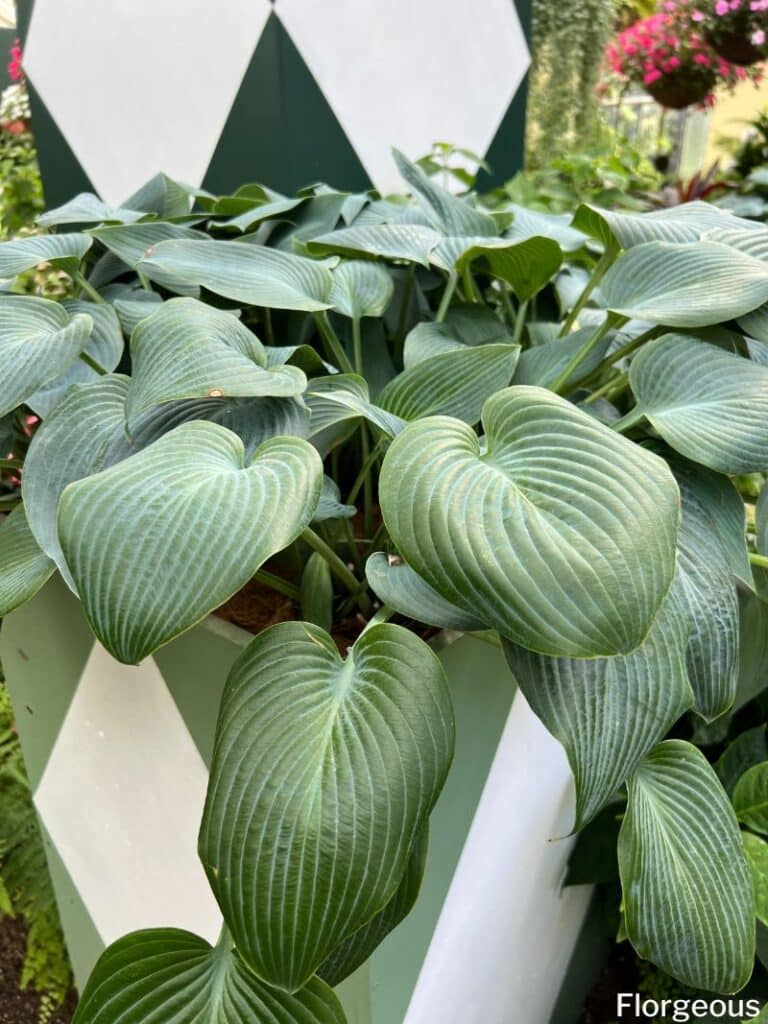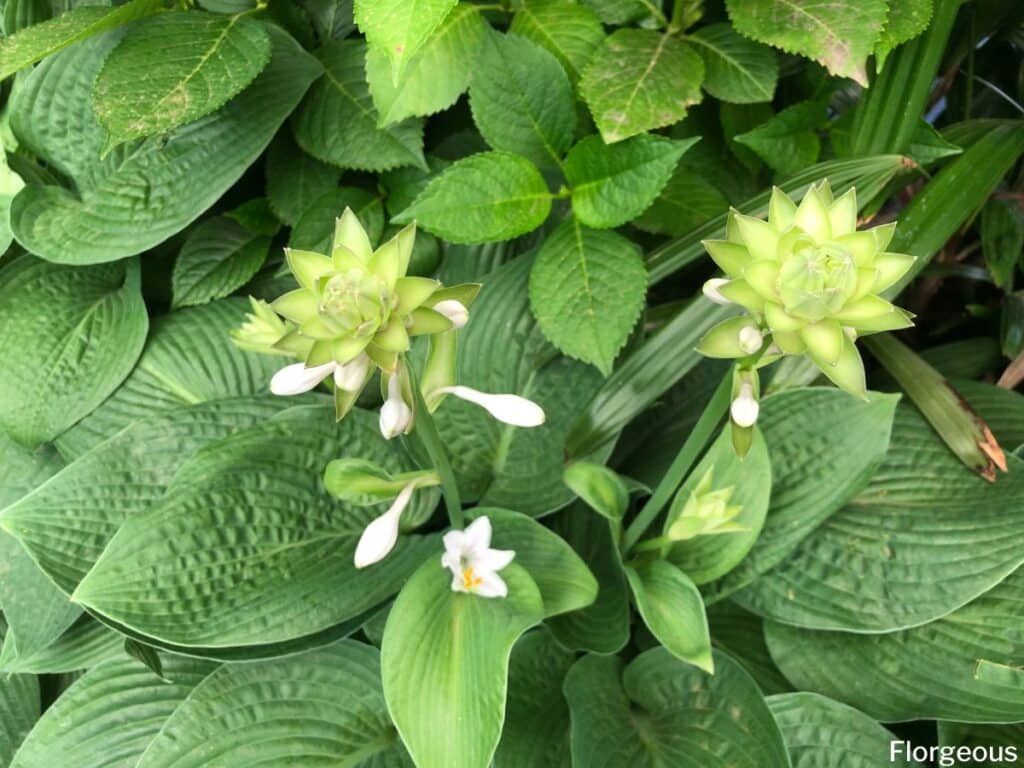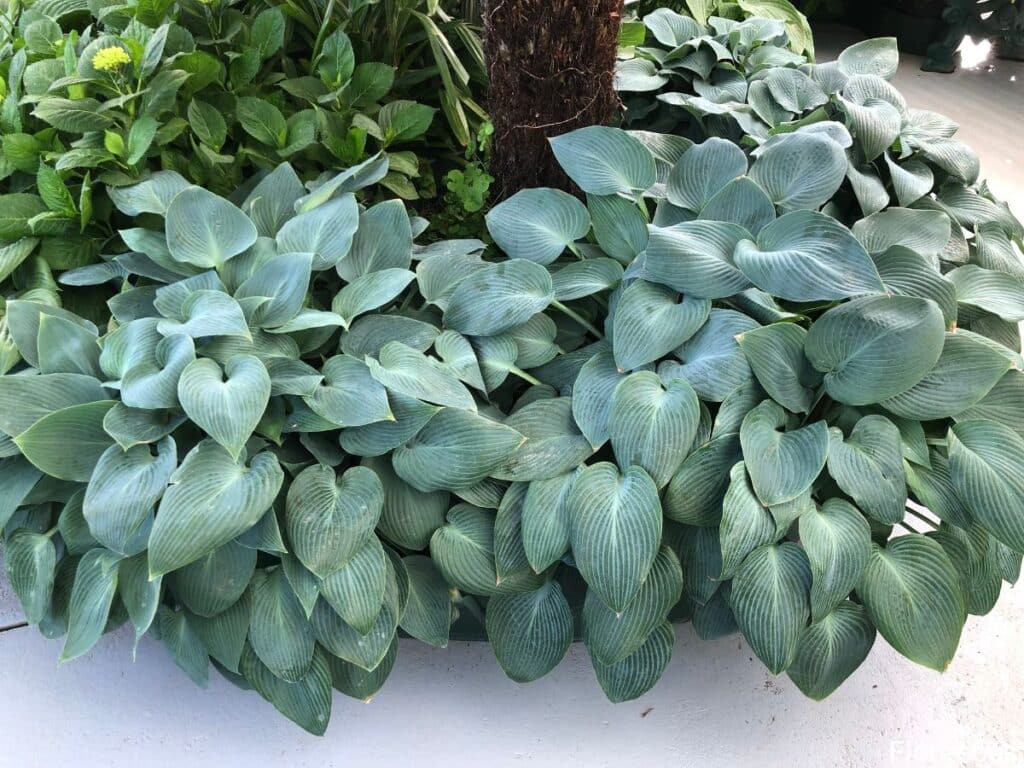Hostas (plantain lilies) are easy-to-grow perennial plants that offer a variety of sizes, shapes, and leaf colors.
With the right care and attention, your hosta can thrive in any garden! Let’s explore how to grow and care for hostas like a pro, especially what to do with hostas in winter.
Plant Facts
| Scientific name | Hosta spp. |
| Common names | Plantain lily, hosta |
| Family | Asparagaceae |
| Plant Type | Herbaceous perennial |
| Height and Width | 6-48″ tall, 10-60″ wide |
| Origin | Asia |
| Flower colors | Purple, pink, white, or pale lavender flowers |
| Foliage color | Pale to dark green, depending on variety (often variegated) |
| Sun Exposure | Partial shade |
| Soil Type & pH | Acidic, loamy, well-drained soil |
| Special features | Toxic to pets, good for containers, shade-tolerant, low maintenance |
How to Grow Hostas
Plantain lilies can be grown as potted plants, but most of the time, planting hostas is done outside. When planting your hostas in the ground, choose a spot with well-drained soil that is sheltered from strong winds.
If you’re planning to plant hostas together in a group in a bed or border, leave at least 18 inches of space between them so they have plenty of room to spread out.
Propagation
The first step in propagating hostas is to select healthy plants that you would like to propagate. Look for hosta plants that have thick leaves and thick root systems. If the plants are too small or not growing well, it may be best to choose another option.
Once you have chosen your plant, it’s time to dig around it gently with a shovel or trowel. Be sure not to dig up too much soil around the plant as this can damage the roots and cause stress on the plant itself.
Once you have carefully dug up your hosta plant, use your hands or some gardening tools like pruning shears or scissors to separate the crown into sections, each containing several shoots and some root material attached.
Be sure not to remove all of the root material from each section, as this will weaken them and make them more prone to disease later on down the road. Be sure also not to break off any shoots; if they don’t come away easily, leave them attached until later when they are more mature and better able to handle being transplanted into their new home in your garden beds or containers.
Soil
Plantain lilies prefer moist, rich soils that are slightly acidic with a pH between 6 and 7. The ideal soil type for hostas should also include plenty of organic matter such as compost or aged manure. This organic material not only helps to retain moisture but also improves the overall structure of the soil, making it easier for roots to penetrate and grow. In addition, adding compost or other organic material will also provide essential nutrients needed by hostas to flourish.
If your garden does not naturally possess all the desired characteristics for optimal growth, you can amend your soil by adding certain materials to improve its quality. Adding sand or gypsum will help break up clay soils, while peat moss or other organic matter can help increase moisture retention and nutrient levels in sandy soils.
It’s important to keep in mind that if you add too much amendment material at once, it may affect the existing pH balance of your soil so make sure you test often during the process and adjust accordingly if necessary. Mulching around hosta plants with shredded bark or straw can help maintain an even moisture level throughout their growing season.
Pruning
Knowing when to prune your hostas is an important part of the process. Generally speaking, you should start pruning during late winter or early spring. Hosta leaves need to regrow before the summer months hit. If you wait until later in the season, the plant won’t have enough time to recover before it gets too hot and dry out.
The best place to prune your hosta is at the base of each leaf. You want to make sure that you’re only pruning away dead or damaged leaves and not healthy ones. This will help promote new growth in your plant while still keeping its existing structure intact.
It’s a good rule of thumb to remove spent flower stalks from your plants to ensure attractive foliage and more pale violet flowers all season, too.
Repotting and Transplanting
If your hosta is growing in an outdoor space or garden bed, then it may need to be transplanted if it appears crowded or is not receiving enough light or water.
To do this, gently remove the plant from its current container/location by gripping around the base of the stem and slowly pulling upward while gently wiggling back and forth until freed.
Place it into a new container with fresh soil up to 2-3 inches below the rim. Make sure that whatever container you use has adequate drainage holes at the bottom (or drill some yourself if needed).

Hosta Care Tips
Hostas are one of the most popular perennials for shade gardens, thanks to their lush foliage and low-maintenance care.
With just a few simple steps, you can keep your hostas looking their best all season long! Let’s take a look at some of the basics of how to care for a hosta plant.
Water
The best time to water your hostas is in the morning, before it gets too hot. This will give them a chance to absorb the moisture before temperatures rise, preventing excess evaporation. As far as how much water they need, this depends on the size of your plant and how hot it is outside.
Generally speaking, you should soak your hostas once every two weeks in summertime, but if temperatures start climbing above 90 degrees Fahrenheit, more frequent watering may be necessary.
If you’re not sure how much water your plants need, use the “finger test” – stick your finger into the soil about 2 inches deep, and if it’s dry, then give them a good soaking until the soil is moist but not soggy.
Sunlight
Hostas flower needs a minimum of four hours of direct sunlight per day but no more than six or seven hours. Any more than that, and the leaves may burn. The best time for direct sunlight is during the early morning or late afternoon when the sun is less intense.
Growing hostas in partially shaded locations rather than full sun spots are ideal, as they are native to woodlands and shade gardens. However, if you live in an area with higher temperatures, they may do better in dappled shade or filtered light.
Temperature and Humidity
Hostas thrive in mild temperatures, as long as they don’t drop below 40°F or rise above 80°F. If temperatures do get too hot or cold, the hosta leaves will start to wilt and eventually die off.
Hostas need moderate humidity levels between 50% and 70%. Too much humidity can cause fungal diseases such as powdery mildew or root rot, while not enough humidity can cause leaf scorch or wilting. The best way to maintain a suitable level of humidity for your hostas is by keeping their soil evenly moist throughout the growing season and avoiding overwatering them.
You can also mist their leaves every few days with water if necessary.
Fertilizer
When it comes to fertilizing hostas, less is more. Too much fertilizer can actually burn your plants or cause them to become overly top heavy and topple over due to excess growth.
The best type of fertilizer for hostas is one that contains a balanced mix of nitrogen, phosphorus, and potassium as well as trace elements such as iron and magnesium.
Pest and diseases
Let’s take a look at some of the most common pests and diseases that affect hostas.
Foliar Nematodes
Foliar nematodes are tiny worm-like parasites that feed on the foliage of hostas. They cause yellow, irregular patches on the leaves of the plant, as well as leaf drop. Foliar nematode infestations can also lead to poor growth and stunted development in young plants. The best way to prevent foliar nematode problems is by purchasing plants from reputable nurseries that practice good sanitation methods.
Hosta Virus
Hosta virus is another common pest that affects hostas. Symptoms include yellow veining or mottling on the leaves, distorted or stunted foliage, and discoloration or death of younger leaves. Unfortunately, there is no cure for viral infections; infected plants must be destroyed in order to prevent further spread of the virus.
Slugs and Snails
Slugs and snails are two of the most common pests that attack hosta plants. Slugs and snails feed on the leaves of hosta plants, which causes them to become discolored or even completely destroyed. To deter slugs and snails from attacking your hostas, place copper tape around the base of each plant. The copper gives off an electrical charge which will repel these pests.
Fungal Diseases
Hosta plants are also vulnerable to fungal diseases such as powdery mildew or crown rot. Powdery mildew is characterized by white spots on the leaves while crown rot causes yellowing foliage followed by wilting leaves at the bottom of the plant. To prevent fungal diseases from developing on your hosta plants, make sure to water them deeply but infrequently as too much water can lead to fungal disease development.
Aphids
Aphids are tiny bugs that feed on sap from plants, including hostas, causing damage such as yellowing or curling leaves or distortion in new growth buds. To get rid of aphids on your hostas, try using insecticidal soap or neem oil sprayed directly onto the affected area twice a week until all signs of aphids have disappeared from your garden beds or pots.
Companion Planting
When choosing companion plants for hostas, there are several factors to consider to ensure a successful pairing such as having similar growing conditions, height and shape, and complementary foliage.
How to Prepare Hostas for Winter
When it comes to hosta winter care, one of the most important things to keep in mind is protecting your hosta from frost damage.
So, how do you winterize hostas?
While many people think that mulching with wood chips or other heavy materials is the best way to protect their plants from frost damage, this is not necessarily true. Mulch can actually trap moisture and cause rot in the roots.
Instead, try using a thin layer of straw or leaves as a ground cover around your hosta plants. This will help insulate them against cold temperatures while still allowing air and water to reach the roots.
Make sure to remove any dead foliage before the first frost so it doesn’t trap moisture around the base of your hosta plants.
Another important step in preparing for winter is making sure that your hostas are well-watered before cold weather sets in. This will help ensure that they don’t dry out over the winter months when temperatures drop below freezing and snow may cover them up for extended periods of time.
As with any other plants, make sure not to overwater them—but do give them one thorough watering right before winter sets in so their roots have plenty of moisture during cold weather.
Finally, make sure that you prune back any dead or dying foliage before winter sets in so that it doesn’t trap moisture around the base of your hosta plants. This will help ensure that they go into dormancy with healthy roots and stems which will enable them to thrive come springtime.
If you live in an area where temperatures drop below freezing for extended periods of time during winter months, consider covering up your hostas with burlap or another type of fabric until springtime rolls around again—this will provide an extra layer of protection against extreme cold temperatures that could otherwise be damaging to their health.
What Do Hosta Flowers Look Like?

Unlike other common flowering plants, hostas are typically planted for their gorgeous foliage rather than their flowers, which makes them less of a focal point of the plant. Hosta flowers usually bloom from mid to late summer.
The flowers of hosta plants are funnel-shaped or trumpet-shaped and look like small lilies. These purple flowers grow on tall spikes that protrude above the plant’s foliage and are usually fragrant.
Common Varieties and Hosta Cultivars
These hardy perennials come in a variety of shapes and sizes, making them a great choice for any garden. From large-leaved varieties to small-leaved cultivars with lime green leaves, there is a hosta that can fit almost any space or purpose.
Let’s take a closer look at some of the common varieties and cultivars of hostas available:
- Hosta ‘Fortunei’
- Hosta ‘Blue Angel’
- Hosta ‘Blue Mouse Ears’ (‘Blue Mouse Ears’ is a miniature variety with tiny hosta flowers and deep green leaves)
- Hosta ‘Guacome’ (which has apple green leaves with blue-green edges)
- Hosta ‘Shogun’
- Hosta ‘Stained Glass’ (which has shiny gold leaves and dark green margins)
- Hosta ‘Sum and Substance’
FAQs
Do hostas need full sun or shade?
Hostas prefer partial to full shade, although some varieties can tolerate morning sun or dappled sunlight. In hot climates, providing them with morning sun and afternoon shade can prevent leaf scorching.
How do you keep hostas looking good?
To keep hostas looking good, provide them with adequate shade, well-draining soil, and consistent moisture.
Are hostas high maintenance?
No, Hostas are generally considered low-maintenance plants, but they do have specific needs.
Can hostas survive in pots?
Yes, hostas can survive and even thrive in pots or containers, provided they have suitable growing conditions. Use a large container with good drainage, high-quality potting mix, and adequate shade. Water regularly to keep the soil evenly moist, and fertilize occasionally during the growing season.
Conclusion
Growing and caring for a beautiful hosta garden is easier than ever thanks to these tips! From providing proper watering to using the right fertilization techniques, you can create an eye-catching display in no time at all.







